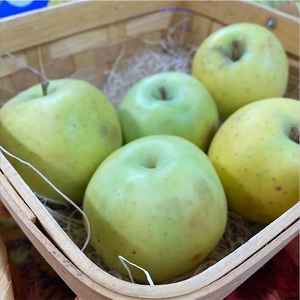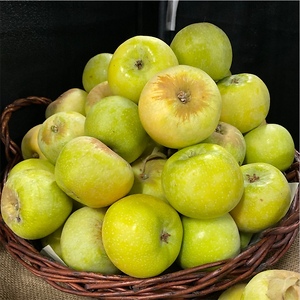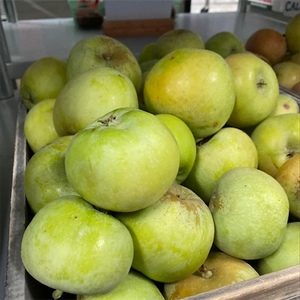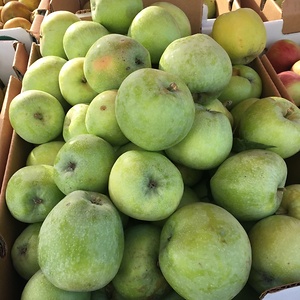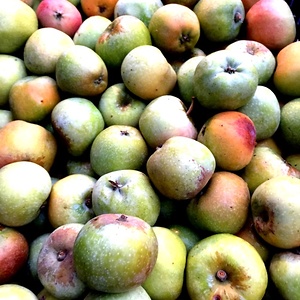


White Pearmain Apples
Estimated Inventory, lb : 0
Description/Taste
White Pearmain apples vary in size, depending on growing conditions, but are generally medium to large fruits with a round to conical shape. The skin is smooth, waxy, and tough, ranging in color from pale green to yellow, with a partial red blush on the side exposed to the most sunlight. The skin is also covered in white lenticels and bears light brown russet around the stem. Underneath the surface, the white to yellow flesh is fine-grained, crisp, firm, and aqueous, encasing a large, central, fibrous core filled with dark brown-black, oval seeds. White Pearmain apples are aromatic, dense, and chewy with a subtly sweet, subacid flavor. As the fruit is kept in storage, it will develop a soft, pear-flavored undertone.
Seasons/Availability
White Pearmain apples are available in the fall.
Current Facts
White Pearmain apples, botanically classified as Malus domestica, are a late-season variety belonging to the Rosaceae family. The heirloom apple is a very old variety, having been documented before 1850, and is known by many other names, including White Winter Pearmain, Winter Queening, Campbellite, Griffin’s Pearmain, and Winter Quoining. White Pearmain apples were once one of the most popular varieties in the United States, grown during the 19th century, but as apple cultivation expanded, many new cultivars overshadowed the heirloom apple. In the modern-day, White Pearmain apples are not commercially cultivated and are a specialty variety grown through select farms as an all-purpose apple. Despite their rarity, White Pearmain apples are highly favored among apple enthusiasts as a fresh eating cultivar and are frequently cultivated in home gardens for their heavy yields, adaptable nature, and pollination capabilities.
Nutritional Value
White Pearmain apples are a good source of fiber to regulate the digestive tract and contain vitamins A and C, which are antioxidants that strengthen the immune system while reducing inflammation. The apples also provide lower amounts of potassium and boron, which are primarily found within the skin.
Applications
White Pearmain apples are best suited for raw applications as their sweet flavor is showcased when consumed fresh, out-of-hand. The variety is most commonly used as a dessert apple, or it can be sliced and served with dips, chopped and tossed into green salads, cut and mixed into grain bowls, or used as a fresh topping over waffles and yogurt. The apples can also be pressed into juice and made into cider or baked into muffins, cakes, bread, pancakes, and bars. When baking, it is recommended to balance the White Pearmain's sweet flavor with tart apple varieties, including granny smith, rome, or mutsu. Blending flavors will develop a rich taste, especially when making pies, tarts, and crisps. In addition to baked preparations, White Pearmain apples can be chopped and stuffed in winter squashes, cooked with roasted meats, or simmered into sauces, soups, or chutney. White Pearmain apples pair well with pumpkin, fruits such as cranberries, apricots, and oranges, spices such as cinnamon, cloves, ginger, and nutmeg, roasted meats such as poultry, beef, and pork, and nuts such as pistachios, almonds, and walnuts. Whole, unwashed White Pearmain apples will keep 2 to 3 months when placed in cold storage or in the refrigerator's crisper drawer.
Ethnic/Cultural Info
White Pearmain apples were cataloged in the National Fruit Collection in 1946, which is one of the largest collections of apples in the world, featuring over 2,200 varieties. The collection seeks to preserve genetic diversity and register varieties to help growers expand their knowledge on available cultivars for continued apple breeding efforts. This collection is also used to host The National Apple Festival, which is an annual fall event conducted in partnership with Brogdale Farm in Kent, England. During the apple celebration, visitors can participate in educational talks centered on apple cultivation, have fruits from their home gardens identified, and attend live cooking demonstrations using a wide array of apple cultivars. The festival also features heirloom apples in massive displays, where visitors can sample the rare varieties before purchasing the fruits.
Geography/History
The origin of White Pearmain apples is heavily debated among experts. Many pomologists connect the variety to older apples of the same name from Norfolk, England, believed to have been found as early as 1200 BCE. There are also a number of experts who consider the variety to be of American descent, developed in 1849 from early tree grafting in the Eastern United States. Despite their shrouded origin, in 1858, White Pearmain apples were officially documented as a variety by the American Pomological Society. The cultivar was also introduced into South Africa in the mid-1900s, where it was highly favored for commercial cultivation until the late 20th century. Today White Pearmain apples are cultivated on a small scale through select growers in Europe, the United States, and South Africa and can be found through specialty grocers and farmers markets. The White Pearmain apples featured in the photograph above were grown through Windrose Farm in Paso Robles, California.
Recipe Ideas
Recipes that include White Pearmain Apples. One



